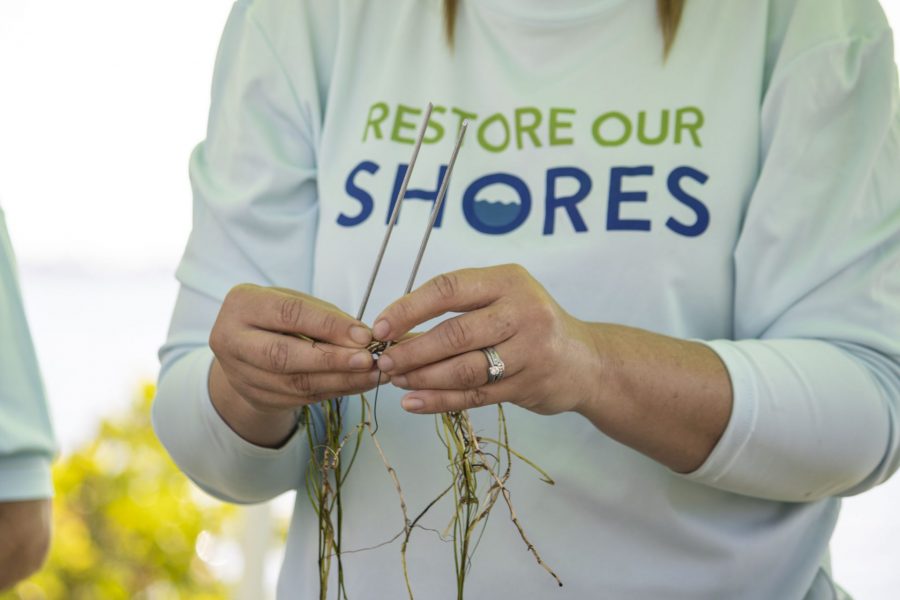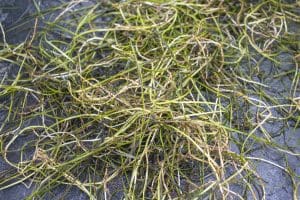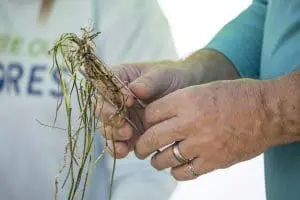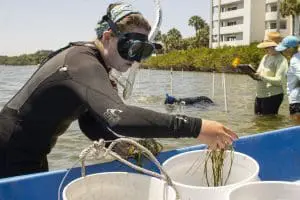

Coming to a lagoon near you: Seagrass!
We’re working to bring back seagrass to the Indian River Lagoon!
Our Restore Our Shores (ROS) conservation program has started planting small beds of seagrass in the lagoon for a new experimental project. We want to learn more about where larger seagrass restoration efforts would thrive. After just a few weeks, we’ve already found seagrass growing at many of the initial sites, so we’re very hopeful about the rest of our plantings!
 Our ROS team, along with partners St Johns River Water Management District and the Indian River Lagoon National Estuary Programs (IRL NEP), have begun planting 24 seagrass beds in 17 locations in the lagoon with the goal of monitoring the sites over the next year. This pilot program is being funded by lagoon loving community members!
Our ROS team, along with partners St Johns River Water Management District and the Indian River Lagoon National Estuary Programs (IRL NEP), have begun planting 24 seagrass beds in 17 locations in the lagoon with the goal of monitoring the sites over the next year. This pilot program is being funded by lagoon loving community members!
We’re so thankful to our community and partners for their work on this project. Our incredible ROS volunteers have helped with the initial plantings and will be a part of monitoring. About 215 total square feet of seagrass will be planted at each bed. While we continue to build our own seagrass nursery funded by IRL NEP, we used shoal grass purchased from the Florida Oceanographic Society for this current monitoring project. This type of seagrass is known as a “pioneer species” – it’s not as picky about light or salinity like some other species like manatee or turtle grass.
 After carefully outlining the areas for the beds, our ROS team of staff and volunteers inspected the sites to note algae, other seagrasses and other potential factors present that may affect the new seagrass beds. The seagrass plants were gently wrapped onto floral wire, a material that should degrade over time, which is used to better anchor the plant in the water. The roots of the plants are then methodically planted into the lagoon floor at certain distances from each other. Exclusion devices were placed at certain areas of the bed to test their effectiveness.
After carefully outlining the areas for the beds, our ROS team of staff and volunteers inspected the sites to note algae, other seagrasses and other potential factors present that may affect the new seagrass beds. The seagrass plants were gently wrapped onto floral wire, a material that should degrade over time, which is used to better anchor the plant in the water. The roots of the plants are then methodically planted into the lagoon floor at certain distances from each other. Exclusion devices were placed at certain areas of the bed to test their effectiveness.
“This is going to tell us more about where to or where not to do seagrass restoration in the lagoon’s current water quality conditions– and what methodologies we should explore,” said Olivia Escandell, ROS conservation manager.
When monitoring these beds in the future, our ROS team will take note of how the planted seagrasses are faring, what other seagrasses or algae have grown in the bed, and more. In a year’s time, the results of this initial project should help identify the best locations for bigger seagrass beds to be planted.
 The Indian River Lagoon is a seagrass-based ecosystem. Seagrass meadows used to be prolific in the lagoon, offering a habitat and food source to a number of its inhabitants. Seagrasses also anchor the seafloor and slow waves, protecting the shoreline. Algae superblooms brought on by nutrient pollutants in wastewater and stormwater blocked the sunlight to these meadows, killing off acres of seagrass – some nearly completely.
The Indian River Lagoon is a seagrass-based ecosystem. Seagrass meadows used to be prolific in the lagoon, offering a habitat and food source to a number of its inhabitants. Seagrasses also anchor the seafloor and slow waves, protecting the shoreline. Algae superblooms brought on by nutrient pollutants in wastewater and stormwater blocked the sunlight to these meadows, killing off acres of seagrass – some nearly completely.
“You can’t grow a plant in a closet,” Olivia said.
Our ROS team continues to replenish healthy populations of oysters, clams and mangroves, in an effort to reestablish those organisms that are crucial to a balanced lagoon ecosystem. Still, more work is needed to continue helping the Indian River Lagoon.
“We’re not going to plant ourselves out of this problem, but we hope to accelerate restoration,” Olivia said. “There’s a lot of other work that needs to happen to reduce nutrients making their way into the lagoon.”
YOU can help with this! The care we provide our lawns at home impacts the health of our neighborhoods’ habitats. When we use too much chemical fertilizer or forget to clean up our pet’s waste, those excess nutrients wash from our lawns into the Indian River Lagoon. This creates the perfect environment for algae growth, which kills off the native seagrasses that manatees depend on for survival. Help keep manatees and our neighborhood habitats healthy by reducing the use of chemical fertilizers and immediately cleaning up after your dog.
Brevard Zoo is an independent, not-for-profit organization that receives no recurring government funding for our operating costs. Your generous support enables us to continue to serve our community and continue our vital animal wellness, education and conservation programs.